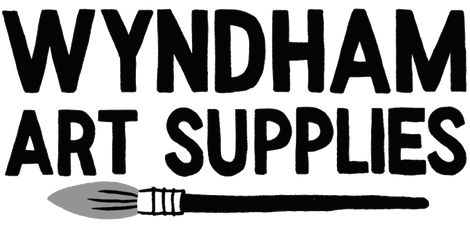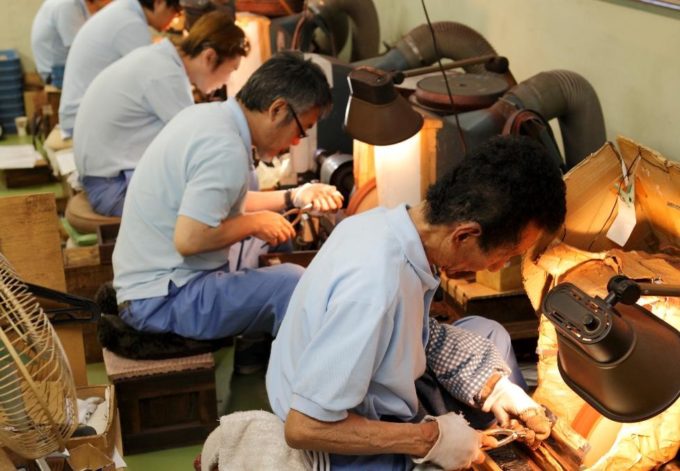View the full range of blades available from Yoshiharu here
[Article Reposted from Yoshiharu]
Please note: This article was originally published in Japanese. We have done our best to translate faithfully, but can't guarantee our translation is completely accurate
Here is an introduction to the manufacturing process of carving knives.
We will explain step by step how a carving knife is made from raw material, to finished tool
Step 1: Drilling
The blade shape is cut out from the steel plate.
 The shape of the carving knife blade is cut out from a rectangular steel plate measuring approximately 50 cm in length and 20 cm in width.
The shape of the carving knife blade is cut out from a rectangular steel plate measuring approximately 50 cm in length and 20 cm in width.
After inspection, the removed blades are sent to the next process in batches of approximately 5,000 to 10,000.
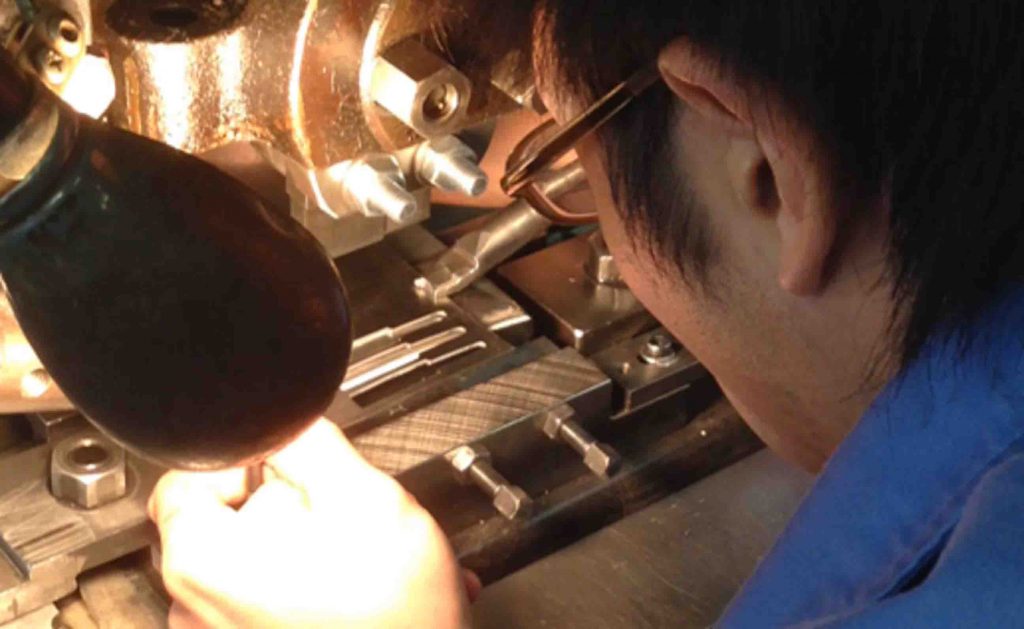
At our company, the removal is done by hand.
A skilled craftsman can pluck more than 10,000 pieces a day.
Step 2: Bending
Bend into the desired blade shape using a press

During the "punching" process, all of the material remains flat.
In this next process, the blade is bent using an automatic or manual press to form the desired blade shape (by bending the blade for a triangular knife, adding a radius for a round knife, etc.).
One piece of material is removed from the stack using air and placed on top of the "female mold."
After that, a "male mold" comes down from above and bends the metal into the desired shape.
The bent material is then sent by air down a slide into a case.

Even our "flat" products such as flat swords and cutting knives have a curved underside of the blade for "back-pressing" processing (bottom arc processing).
At this stage, the material is still soft and can be easily bent in a press.
A common feature for all blades is that any parts that need to be bent are bent before hardening.
If you try to perform a similar process after hardening, the steel will harden and break with an unnatural snapping noise.
Step 3: Quenching and tempering
Heat treatment at a heat treatment factory to increase hardness

The material bent into the shape of each blade type is then sent to a heat treatment processor to be hardened and tempered to increase its hardness.
In order to achieve the optimum hardness, it is important to keep the temperature and time consistent.
The furnace temperature rises to over 800°C.
Step 4: Back pressing
Shave the back of the blade of a flat tool to make it flat.
 Once the hardening is complete, the material is returned to the company, where the underside of the blade of flat blades such as flat swords and cutting blades is subjected to a backing process.
Once the hardening is complete, the material is returned to the company, where the underside of the blade of flat blades such as flat swords and cutting blades is subjected to a backing process.
A whetstone shaped like a Baumkuchen cake is rotated to sharpen the back of each blade one by one.
 Maruichi carving knives are made with an automatic machine for "backing," but Yoshiharu carving knives, which are made of double-layered steel, are backed by craftsmen one by one by hand.
Maruichi carving knives are made with an automatic machine for "backing," but Yoshiharu carving knives, which are made of double-layered steel, are backed by craftsmen one by one by hand.
In this process, the blade is given a gentle curve and a rounded back shape to sharpen the blade angle and improve cutting performance.
Step 5: Sharpening the blade
Sharpen the rough edge with a whetstone

Finally the blade is attached.
Nowadays, the sharpening process is done by machine.
In the old days, blade sharpening was done by hand.
A circular grinding stone is rotated and the material is pressed against the stone while being cooled with water.
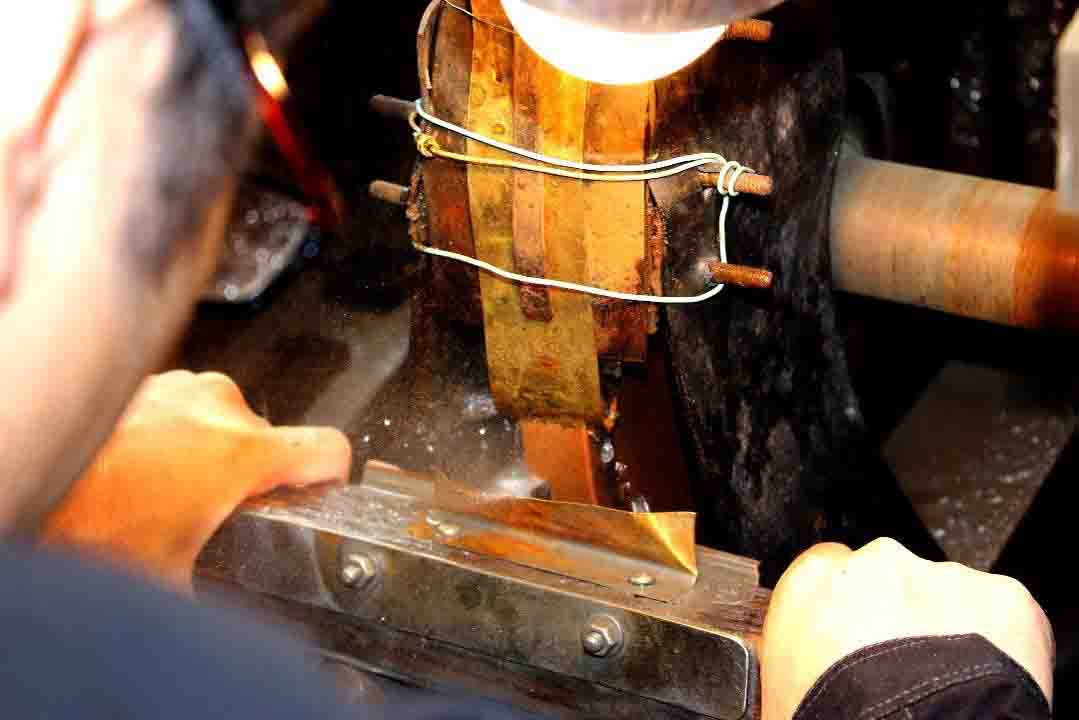
When the carving knife hits the whetstone, sparks fly as the blade is sharpened.
Although the carving knife has a blade attached like this, there is a burr on the back of the blade and it is not yet able to cut.
Step 6: Finishing
The blade is polished with a buff (feather cloth) to create a sharp cutting edge.

Once the blade is attached to the material, the craftsman carefully removes any burrs one by one.
A cloth called a "buff" is rotated at high speed and an abrasive is applied.
The cutting edge of the carving knife is polished with a buff coated with an abrasive and burrs are removed as the cutting edge is finished.

It may seem simple, but it is an extremely delicate process; even the slightest error in the angle, time, or strength of the material application can result in unnecessary parts being polished away or areas remaining unpolished, resulting in a loss of sharpness.
The finest sharpness is achieved through meticulous manual work by artisans, something that machines cannot do.
Step 7: Attaching the Handle
The handle and blade are assembled by machine.

The completed blade is then hammered into the handle by a machine.
The handles we manufacture include "wooden handles," "plastic handles," "rubber handles," etc.
During this process, blade inspection is also carried out at the same time.
The standards for blade inspection in this process are extremely strict.
Once the carving knife has been hammered in, it is coated with oil to prevent rust.
Thus, a single carving knife was completed.
Step 8: Packaging
Packing a set of carving knives into a box
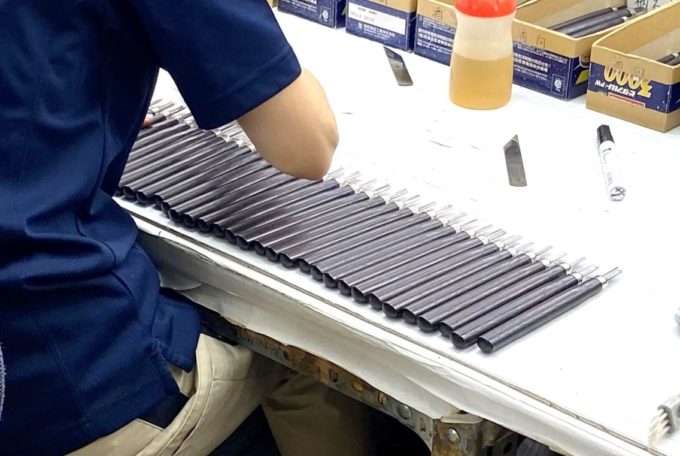
A final inspection of the carving knives is carried out.
Once again, the carving knife is inspected based on the standards to ensure there are no defects.
Depending on the order, individual carving knives are packaged individually or as a set and shipped to the customer.
